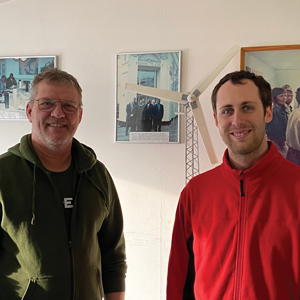 Despite society moving towards ‘big wind’, there are still a number of applications for which small wind can play an important role, especially in remote locations like the Arctic or in developing countries. Why should these communities wait for a green megawatt transition when a kilowatt transition is already possible?
Despite society moving towards ‘big wind’, there are still a number of applications for which small wind can play an important role, especially in remote locations like the Arctic or in developing countries. Why should these communities wait for a green megawatt transition when a kilowatt transition is already possible?By Daniele Pagani, Capacity Building Coordinator & Tonny Brink, CTO, Nordic Folkecenter for Renewable Energy, Denmark
Technological developments during the last 40 years have led the wind industry to reach a very high maturity level – what was once only a vision is now a solid industry, generating large revenues and providing important support in the fight against climate change.
The development which has probably been the most impressive is the size of wind turbines, which can now be compared to the tallest buildings. The increase in size allows for economies of scale – with a subsequent reduction in costs – and increased energy production.
Nevertheless, the ‘big-is-better’ approach is not necessarily the correct one, at least not in all situations – the installation of a large wind turbine requires an important logistical effort involving huge cranes, traffic limitations (have you ever tried to overtake a blade transport on a normal road?) and a landscape with sufficient space available to allow the movement of the equipment. At the Nordic Folkecenter we experience this situation often, being located not far away from the Danish National Test Centre for Large Wind Turbines, where the biggest prototypes are tested. However, moving a crane with 120 trucks is not always an option, especially when isolated areas are considered.
There are several locations around the world which, although blessed by good wind resources, cannot benefit from the technology due to the difficulty in reaching them. Examples of these situations can be found in many developing countries, in the Arctic region and in several remote islands scattered around the world.
These communities have to rely on diesel generators to cover their electrical needs and the central governments often deliver the necessary fuel, even if the process is very inefficient and expensive. This way of acting, often driven by political and strategic reasons, could be replaced by installing local wind turbines which could power these mini-grids, but the logistics associated with this can represent a barrier.
The story is different for small and medium wind turbines (SMWTs), a market which is struggling but which has a large potential. Given the limited dimensions involved, these wind turbines can be easily transported, installed and maintained even in the less transport-friendly locations. Also, their visual (and environmental) impact is lower and they can operate very well in harsh environments, since they can be lowered in case of hurricanes or strong storms.
SMWTs also bring educational and occupational aspects with them, since they allow the development of local skilled technicians who can maintain and repair the turbines, thereby reducing the ‘maintenance trips’ otherwise required.
Tackling these issues and promoting the use of SMWTs are the purposes of the 5th International Conference on Small & Medium Wind Energy, which will take place online on 27–29 April. The event, part of a series of conferences on the topic, will see international experts from both industry and academia discuss the challenges faced by SMWTs and the potential lying in the technology. Participation is free, but registration is required (www.folkecenterevents.net). We hope you will join us in this discussion.








